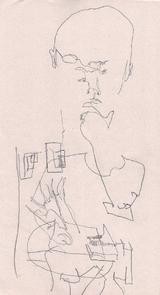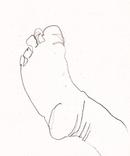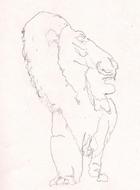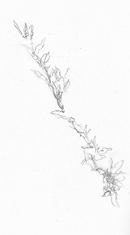In my previous installment of The Naked Beginner I told you about the gesture drawing as I learned it from Kimon Nicolaïdes. Today I’ll tell you about Nicolaïdes’s second great exercise.
The contour drawing shares two characteristics with the gesture drawing: you don’t actually look at the paper as you draw; and the pencil never leaves the page. But, instead of drawing something quickly the way you do with gesture drawing, you let your eyes slowly follow the contours of whatever you’re looking at… and you let your hand slowly draw the very contour your eye is looking at, millimeter by millimeter. It’s another Zen-like meditation, in which your eye and your hand so fuse that you develop the feeling you are actually touching the object or person that you draw. The eye caresses the figure, the hand caresses the paper, and what the eye sees and what the hand draws finally become one.
At first the exercise was surprisingly difficult. I kept wanting to look at the page, not at the object I was trying to draw. I found that I simply didn’t want to let my eyes linger on an image long enough. I'd scan the image in a jerky fashion, stopping at one point and then suddenly moving my eyes jerkily to another point far away. I was impatient, quickly bored, even uncomfortable. This showed me I didn’t live in the moment. I didn’t “stay,” as it were; I “came and went” instead. It also showed me I had never, ever truly looked at the world with my attention properly focused. There’s so much to see when you really look: shape, dimension, proportion, context, expression, perspective, color, light and shadow—the amount of information at your disposal is staggering. There may well be good biological and psychological reasons not to look so closely: you can be utterly overwhelmed by what you perceive!
 And that is the main thing: I was learning to broaden and deepen my perceptions of the world. It’s tempting to think that what separates an artist from a non-artist is the degree of technical expertise: in short, the artist has more and better “technique.” But that is utterly misleading. Artistry is first and foremost about perception. Caravaggio’s accomplishment wasn’t in how he depicted the world, but how he perceived it. Caravaggio, Picasso, Matisse, Kahlo, O'Keefe, Rembrandt, name whom you will—it’s the case with all artists.
And that is the main thing: I was learning to broaden and deepen my perceptions of the world. It’s tempting to think that what separates an artist from a non-artist is the degree of technical expertise: in short, the artist has more and better “technique.” But that is utterly misleading. Artistry is first and foremost about perception. Caravaggio’s accomplishment wasn’t in how he depicted the world, but how he perceived it. Caravaggio, Picasso, Matisse, Kahlo, O'Keefe, Rembrandt, name whom you will—it’s the case with all artists.
My artistic initiation has had little to do with art, and everything to do with perception, with looking, seeing, and touching, with living in the moment, with trusting my instincts, with passing from the known to the unknown.
In fact, I learned so many things from Nicolaïdes’s two basic exercises that I’ll need a whole new blog entry to dissect my experiences and to offer you a few pointers along the way.


